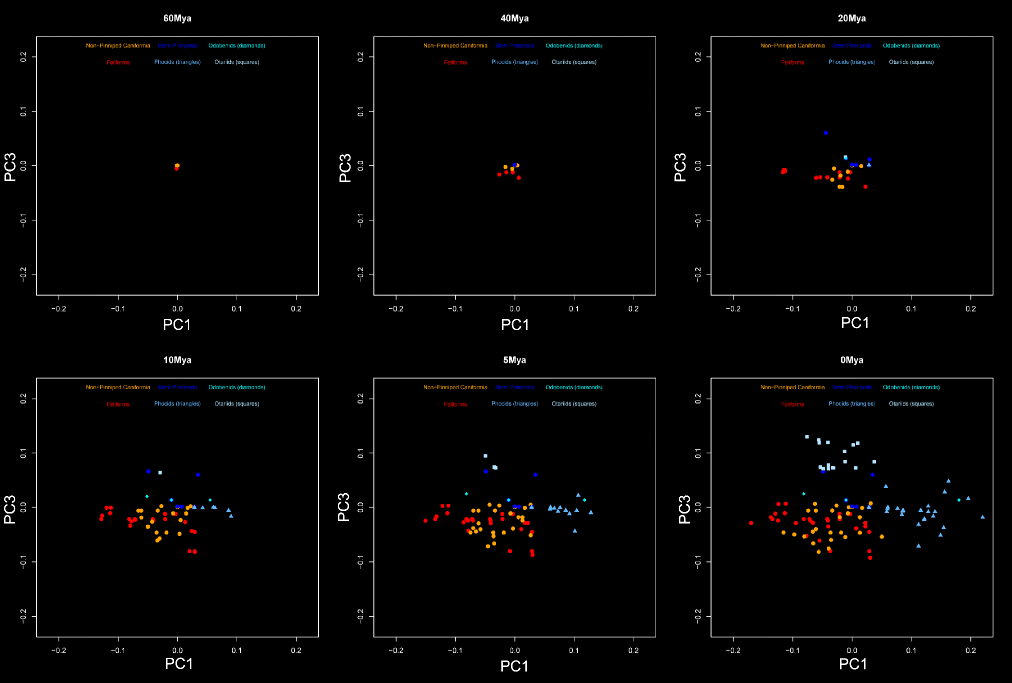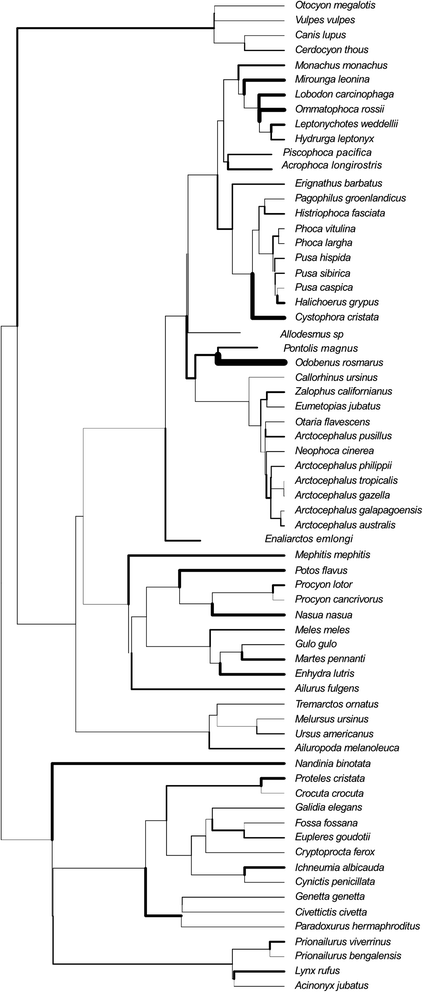Impact of the terrestrial-aquatic transition on disparity and rates of evolution in the carnivoran skull
- PMID: 25648618
- PMCID: PMC4328284
- DOI: 10.1186/s12862-015-0285-5
Impact of the terrestrial-aquatic transition on disparity and rates of evolution in the carnivoran skull
Abstract
Background: Which factors influence the distribution patterns of morphological diversity among clades? The adaptive radiation model predicts that a clade entering new ecological niche will experience high rates of evolution early in its history, followed by a gradual slowing. Here we measure disparity and rates of evolution in Carnivora, specifically focusing on the terrestrial-aquatic transition in Pinnipedia. We analyze fissiped (mostly terrestrial, arboreal, and semi-arboreal, but also including the semi-aquatic otter) and pinniped (secondarily aquatic) carnivorans as a case study of an extreme ecological transition. We used 3D geometric morphometrics to quantify cranial shape in 151 carnivoran specimens (64 fissiped, 87 pinniped) and five exceptionally-preserved fossil pinnipeds, including the stem-pinniped Enaliarctos emlongi. Range-based and variance-based disparity measures were compared between pinnipeds and fissipeds. To distinguish between evolutionary modes, a Brownian motion model was compared to selective regime shifts associated with the terrestrial-aquatic transition and at the base of Pinnipedia. Further, evolutionary patterns were estimated on individual branches using both Ornstein-Uhlenbeck and Independent Evolution models, to examine the origin of pinniped diversity.
Results: Pinnipeds exhibit greater cranial disparity than fissipeds, even though they are less taxonomically diverse and, as a clade nested within fissipeds, phylogenetically younger. Despite this, there is no increase in the rate of morphological evolution at the base of Pinnipedia, as would be predicted by an adaptive radiation model, and a Brownian motion model of evolution is supported. Instead basal pinnipeds populated new areas of morphospace via low to moderate rates of evolution in new directions, followed by later bursts within the crown-group, potentially associated with ecological diversification within the marine realm.
Conclusion: The transition to an aquatic habitat in carnivorans resulted in a shift in cranial morphology without an increase in rate in the stem lineage, contra to the adaptive radiation model. Instead these data suggest a release from evolutionary constraint model, followed by aquatic diversifications within crown families.
Figures







References
-
- Simpson GG. Tempo and Mode in Evolution. New York: Columbia University Press; 1944.
-
- Foote M. The evolution of morphological diversity. Annu Rev Ecol Syst. 1997;28:129–52.
-
- Schluter D. The Ecology of Adaptive Radiation. Oxford: Oxfrod University Press; 2000.
-
- Losos JB. Adaptive radiation, ecological opportunity, and evolutionary determinism. Am Nat. 2010;175(6):623–39. - PubMed
Publication types
MeSH terms
LinkOut - more resources
Full Text Sources
Other Literature Sources

